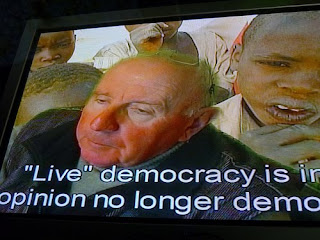Ok there are many many gloom and doom scenarios. Some of them are so obviously instantaneous in their effect that there is no question of when their impact will be felt. Nuclear bombs: instantaneous. Really large asteroid: instantaneous.
In the case of revolutionary upheavals, simple peasant revolts can be very dangerous, and will on occassion take a few years to run their course. But in general your garden variety peasent/workers rebellions tend not to succeed in the long run. The closest that comes to mind is the revolt of Spartacus in Rome.
There needs to be some part of the existing power structure that feels that the current situation is no longer to its advantage, and that a change in the rules is in order. Often this group does not even intend to allie itself with the larger mass of the mobs, but comes to do so as less severe paths of dispute become closed off. In many countries the military is always a good candidate for a change agent elite group. In the case of the former Soviet Union it was the political leadership that accidentally got the ball rolling.
Revolutionary changes therefore often build up over time, but the actual action can be lightning fast.
So let’s pick a popular protest movement: that may be the modern equivelant of our peasents uprising: how about the
Tea Party?
It is of itself a rather defuse group. At the current public protests it tends to comprise many older white folks. The combination of association with the Republican and/or Libertarian crowd, promotion by FOX News, and the ability to get off of work (or be retired) so as to allow attendance at rallies probably combine to create this demographic.
Since I don’t think your typical Tea Partier is influential enough to be part of the initiating agent, we need an elite change agnet group. An obvious group (almost too obvious) group is the
Oath Keepers.
As a dedicated military/law enforcement group ready to uphold (or at least not contravene) the US Constitution, it is not at all difficult to see this group causing some problems: particularly if stationed within the United States.
So is a scenario needed?
The Governor of North Carolina, in her infinite wisdom, has declared through executive order that in a state of emergency it is illegal to transport weapons. Since our state likes to declare emergencies for all sorts of real and potential crises (last winter a town declared an emergency because of the potential of snow), it is not hard to see that in combination with our many military bases and our many weather related crises, that at some point military assistance could get itself involved in a “Constitutional Crises”.
Of course I am being a little flippant, but anyone who has been around ground zero shortly after a punishing hurricane knows, these can be tense times. Arresting some people for carrying guns that they are pulling out of the wreckage of their home or vehicle could get ugly pretty fast. Pile in a bunch of local tea partiers into the lit spark to bulk up the breadth and numbers, and it could get pretty exciting.
So when does it get dangerous: possibly quicker than you might expect.













